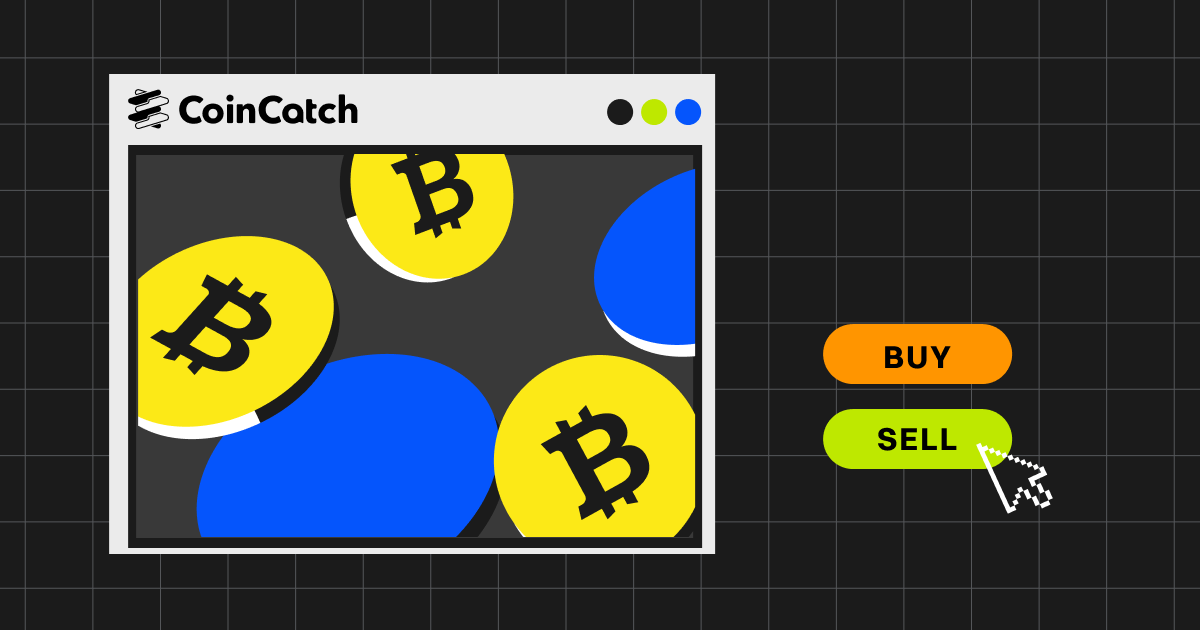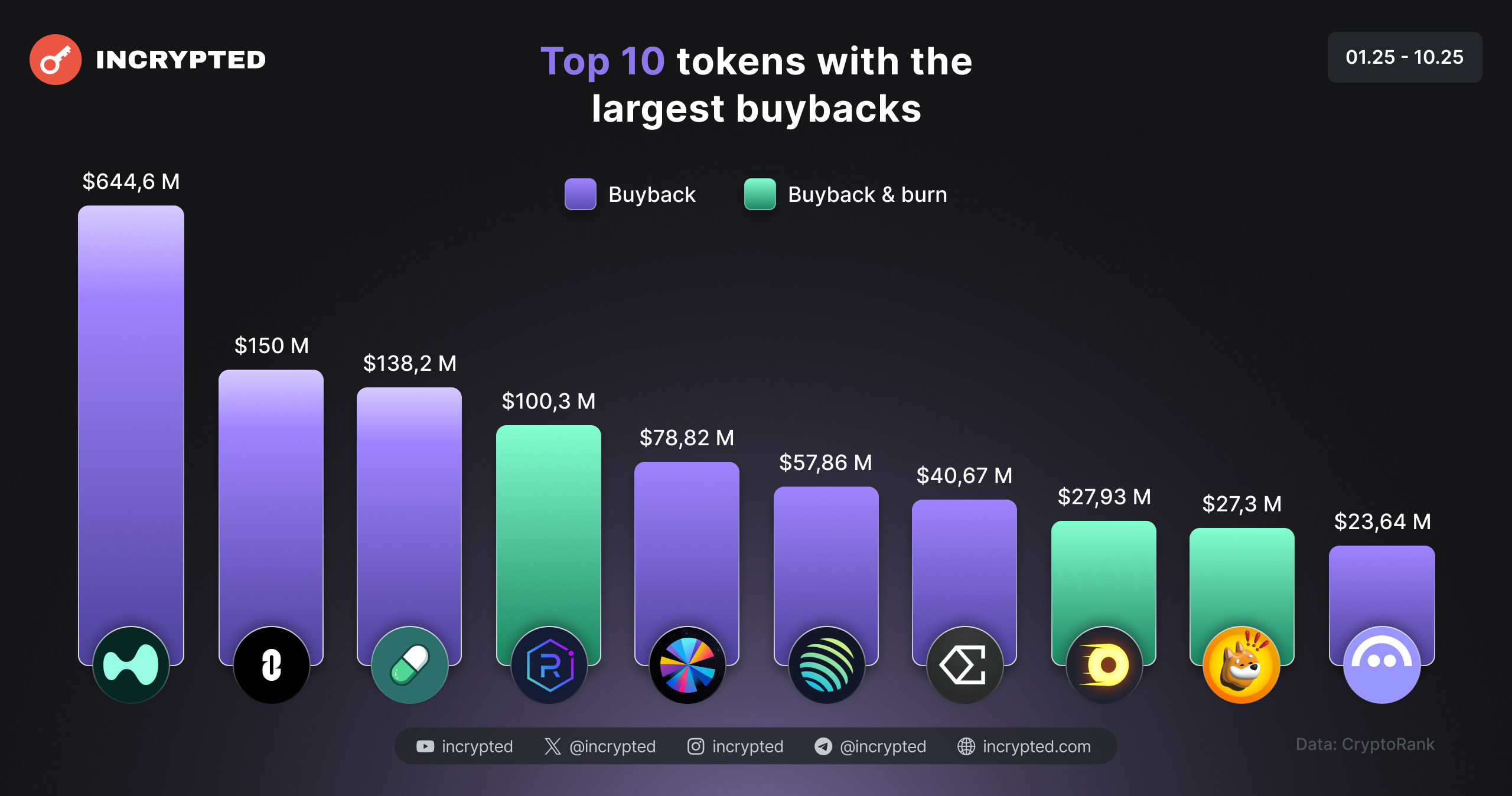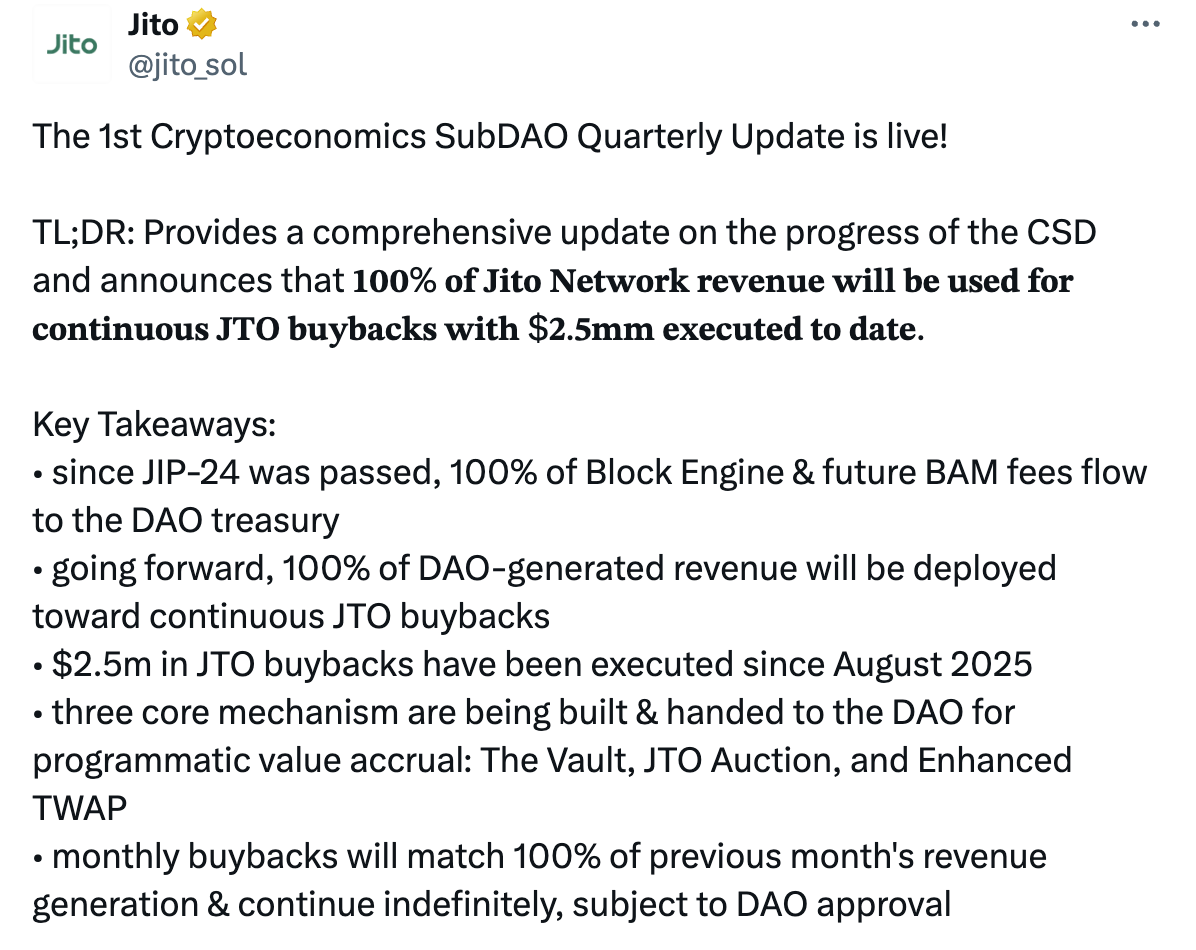Unlike traditional stock buybacks in conventional finance, crypto buybacks leverage blockchain technology to execute transparent, algorithmically-driven repurchases that directly benefit token holders. This innovative approach represents a significant step toward maturity for the cryptocurrency industry, as projects increasingly adopt sophisticated treasury management strategies previously reserved for established public corporations. The recent announcements from Jito and
Hyperliquid
about ambitious buyback programs have ignited both excitement and scrutiny, signaling a potential paradigm shift in how crypto projects manage their token economics and value accrual.
This article examines the growing phenomenon of token buybacks through the lens of two leading implementations. Jito's 100% revenue commitment and Hyperliquid's automated fee-based model. We will explore their mechanics, impact on market structure, and implications for the broader cryptocurrency ecosystem.
What Is a Crypto Buyback?
Crypto buybacks are a process where a project uses its funds to repurchase its own tokens from the open market, reducing the total supply in circulation. This strategy, similar to stock buybacks, can be used to increase scarcity, boost token value, and signal confidence in the project's future. Buybacks can be funded by revenue, a project's treasury, or even trading fees, and the repurchased tokens are often either permanently removed (burned) or used for other purposes, like funding the community or protocol liquidity.
How Buybacks Work?
A buyback is typically announced well in advance by the company and conducted on open cryptocurrency exchanges. The company uses its reserved funds to purchase tokens, which are often then “burned” or permanently removed from circulation. This straightforward process ensures that the tokens are not just bought but also retired, further helping to reduce the overall supply.
Buybacks are a proactive approach for companies to manage their cryptocurrency’s value and supply. They provide stability, build trust, and can make cryptocurrency more attractive to both current holders and potential new investors. As a newcomer to cryptocurrency, understanding the role of buybacks can help you see why they are viewed positively by the community and just how they can influence your next step.
Jito's 100% Revenue Buyback Model
Jito buyback announcement. Source: Jito X account
The Jito Network recently announced a groundbreaking commitment to allocate 100% of its network revenue toward continuous buybacks of its JTO token, representing one of the most aggressive value accrual mechanisms yet seen in decentralized finance. This decision, formalized through the passage of JIP-24, directs all Block Engine fees and future BAM fees directly into the
DAO treasury, which will then be used for monthly token repurchases based on the previous month's revenue generation. The scale of this commitment is unprecedented, whereas many projects allocate only a percentage of revenue or profits to buybacks. Jito has opted for a comprehensive approach that directly links protocol performance to token demand.
The implementation specifics of Jito's buyback program reveal a carefully structured approach designed for sustainability and transparency. Since August, the platform has already executed approximately $2.5 million in buybacks, building upon an initial $1 million buyback completed by the Jito Foundation in early September. The program operates on a continuous cycle rather than episodic interventions, with monthly repurchase amounts matching the preceding month's revenue generation. This creates a predictable and mechanically enforced relationship between protocol usage and token demand as Jito's network activity and revenue increase, so too does the systematic buying pressure on JTO tokens in the open market.
What distinguishes Jito's approach is its governance foundation, with the buyback program receiving formal approval through the decentralized autonomous organization (DAO) structure. This community endorsement represents a significant evolution in how blockchain projects manage treasury assets, shifting control from core developers to token holders who directly benefit from value appreciation mechanisms. The program will continue indefinitely subject to ongoing DAO approval, creating a sustainable mechanism that aligns the interests of protocol users, token holders, and developers through a transparent economic feedback loop.
Hyperliquid’s Leadership in the Buyback Movement
Hyperliquid has emerged as a trailblazer in the buyback trend, allocating approximately $645 million through its Assistance Fund to repurchase 21.36 million HYPE tokens, representing 2.1% of the token’s total supply. The platform employs an automated, on-chain mechanism that channels 97% of its trading fees into continuous HYPE token buybacks. This approach creates sustained buy pressure and significantly reduces the circulating supply.
Hyperliquid’s innovative strategy has not only strengthened its tokenomics but also positioned it as a leader in the decentralized finance (DeFi) derivatives market. Operating with a lean team of just 11 members, Hyperliquid has captured 70% of the DeFi derivatives market share, thanks to its high-speed Layer-1 blockchain infrastructure, HyperCore and HyperEVM.
Buyback Strategies Across Other Crypto Projects
While Hyperliquid leads the buyback movement, other projects have also implemented notable strategies:
LayerZero: Conducted a one-time $150 million buyback of ZRO tokens, representing 5% of its total supply.
Pump.fun: Spent $138 million on PUMP token buybacks, reducing its supply by 3%.
Raydium: Adopted a buyback-and-burn strategy, spending $100 million to reduce the circulating supply of RAY tokens.
GMX: Achieved the highest percentage of supply buybacks, repurchasing 12.9% of its total supply for $20.86 million.
These diverse approaches highlight the flexibility of buybacks as a tool for managing tokenomics, with varying impacts on token scarcity and market dynamics.
How Buybacks Redefine Crypto Scarcity?
The emergence of sophisticated buyback mechanisms represents a fundamental shift in how digital scarcity is created and maintained within cryptocurrency ecosystems. Unlike Bitcoin's fixed supply or Ethereum's burn mechanism, buybacks introduce a dynamic scarcity model that responds directly to protocol performance and market conditions. This creates a more organic form of scarcity that reflects actual usage and value creation rather than predetermined issuance schedules. Projects like Jito and Hyperliteral are effectively pioneering a new economic paradigm where token value accrual becomes intrinsically linked to platform success through systematically engineered scarcity mechanisms.
The economic theory underpinning buyback-driven scarcity combines traditional financial principles with unique crypto-native innovations. In traditional markets, stock buybacks increase earnings per share by reducing outstanding supply, creating value for remaining shareholders. Similarly, token buybacks reduce circulating supply while potentially increasing protocol ownership concentration among committed holders. However, crypto implementations add transparent execution and often incorporate immediate burning of repurchased tokens, permanently removing them from circulation. This creates a deflationary counterbalance to typical token emission schedules, potentially offsetting vesting unlocks and incentive-based inflation.
Different projects are approaching this scarcity creation through varied models that reflect their specific economic circumstances and strategic priorities:
-
Revenue-Based Scarcity (Jito): By committing 100% of network revenue to buybacks, Jito creates a direct correlation between platform usage and token scarcity. As revenue increases, so does the constant buying pressure that systematically reduces circulating supply.
-
Fee-Funded Scarcity (Hyperliquid): Allocating 97% of trading fees to buybacks ties scarcity directly to platform activity volume, creating a reflexive relationship where increased usage directly translates to increased token demand.
-
Deflationary Staking (Five Pillars DeFi): Some protocols like Five Pillars DeFi employ a stake-and-burn model where 100% of staked tokens are permanently burned, creating programmed scarcity through ecosystem participation.
The broader movement toward engineered digital scarcity extends beyond buybacks, with various projects experimenting with complementary mechanisms.
Criticism and Risks of Token Buybacks
Despite their popularity, token buybacks are not without criticism. Key concerns include:
-
Liquidity Risks: By allocating substantial resources to buybacks, projects may reduce treasury diversification and potentially face liquidity shortages during market stress periods.
-
Centralization Dangers: Large-scale buybacks could potentially lead to increased token concentration among whales or the project treasury itself, undermining decentralization principles.
-
Incentive Misalignment: Overemphasis on buybacks might lead projects to prioritize short-term price support over long-term ecosystem development and innovation.
The institutional response to buyback programs also presents complex dynamics, as seen in reactions to Ripple's $1 billion XRP buyback plan. While such initiatives often generate positive price momentum, they can also create tensions between retail and institutional interests, potentially leading to a supply squeeze that prices smaller investors out of the market. This highlights the delicate balance projects must strike between creating value for all holders and designing mechanisms that might inadvertently favor larger participants with disproportionate market influence.
The Future of Buybacks in Crypto
As token buybacks evolve from experimental concepts to established value accrual mechanisms, their implementation is likely to become more sophisticated, targeted, and integrated with other DeFi primitives. We are already observing the early stages of this evolution, with projects experimenting with automated execution, revenue-based triggers, and governance-controlled parameters that allow for dynamic adjustment in response to changing market conditions. The next generation of buyback mechanisms will likely incorporate more nuanced approaches that balance immediate value return with long-term treasury management, possibly incorporating elements like treasury diversification and yield-as-a-service to generate sustainable funding for buyback initiatives without compromising fiscal stability.
The competitive landscape is also poised to drive innovation in buyback design as projects seek differentiation in an increasingly crowded market. We may see the emergence of sector-specific models tailored to different types of protocols. For example, DEXs might implement volume-based buyback triggers, while lending protocols could link buybacks to interest revenue. This specialization would represent a maturation from the current one-size-fits-all approach toward more customized mechanisms that reflect each project's unique value drivers and revenue patterns. The success of early adopters like Jito and Hyperliquid is already creating competitive pressure for other projects to implement similarly robust value accrual mechanisms or risk being perceived as economically inferior.
Looking further ahead, several emerging trends suggest potential directions for buyback evolution:
-
Cross-Protocol Integration: Buyback mechanisms that automatically deploy across multiple protocols or chains, creating diversified value accrual streams.
-
Structured Buyback Vehicles: Dedicated entities similar to Ripple's digital-asset treasury (DAT) that professionally manage buyback execution and treasury assets.
-
Dynamic Parameter Adjustment: Buyback programs with governance-controlled parameters that can be adjusted based on market conditions, treasury health, or protocol performance metrics.
The regulatory clarity that will inevitably emerge over time is also likely to shape how buyback mechanisms evolve. As regulatory frameworks around cryptocurrency become more defined, projects may need to adapt their approaches to ensure compliance—potentially incorporating transparency enhancements, reporting standards, or purchase limitations that align with securities regulations in various jurisdictions. This regulatory maturation, while potentially constraining some innovative approaches, could also lend legitimacy and institutional confidence to properly structured buyback programs.
Conclusion
The rapid adoption of token buybacks by leading protocols like Jito and Hyperliquid represents a significant maturation in crypto economic design, marking a transition from purely inflationary models toward more balanced approaches that incorporate deliberate scarcity creation. These mechanisms create transparent links between protocol performance and token value, potentially addressing longstanding criticisms about the fundamental utility of certain tokens. By allocating substantial portions of revenue. In Jito's case, 100% systematic repurchases, projects are establishing concrete value accrual pathways that benefit token holders directly and measurably.
However, the long-term impact of this trend remains uncertain, with significant questions about sustainability, regulatory treatment, and market effects still unanswered. The coming years will serve as a crucial testing ground for these mechanisms, particularly as major token unlocks and potential market downturns challenge their resilience. Projects that have implemented aggressive buyback programs will need to demonstrate their ability to maintain these initiatives through market cycles without compromising development resources or operational stability.
References:
Cryptounity.org. (n.d.). Crypto dictionary: What is a buyback?. Cryptounity.org. https://cryptounity.org/news/crypto-dictionary-what-is-a-buyback/
CoinCatch Team
Disclaimer:
Digital asset prices carry high market risk and price volatility. You should carefully consider your investment experience, financial situation, investment objectives, and risk tolerance. CoinCatch is not responsible for any losses that may occur. This article should not be considered financial advice.



